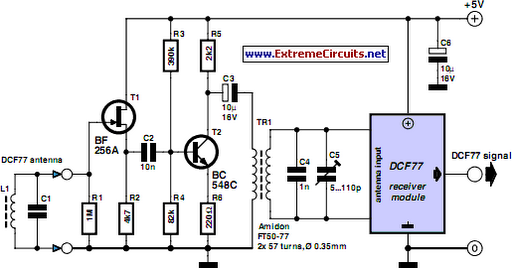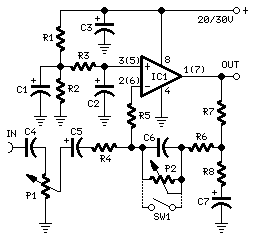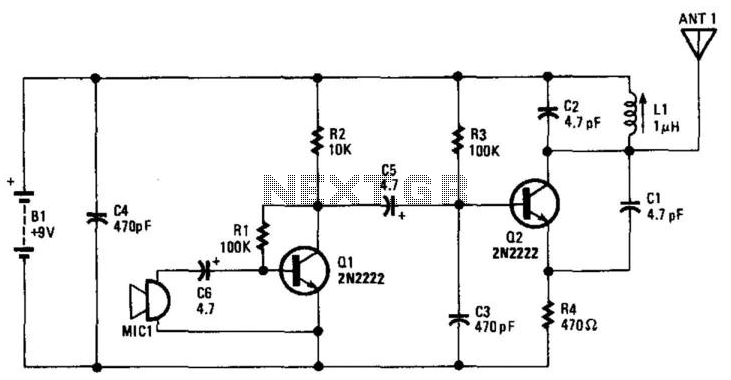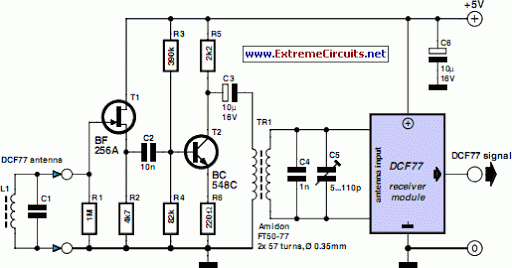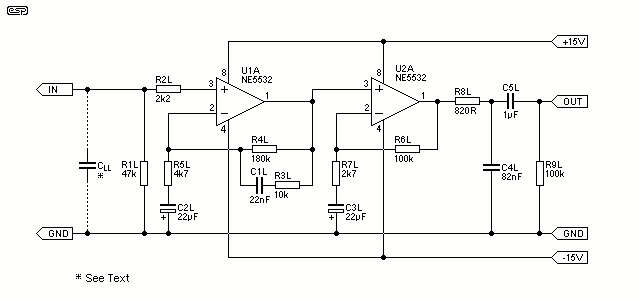
Dynamic Microphone Preamp
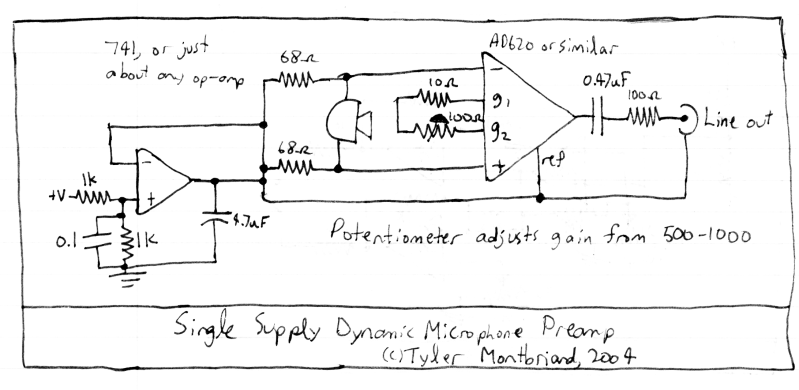
This circuit amplifies the output from a 150-ohm dynamic microphone to line level using an instrumentation amplifier. Instrumentation amplifiers are similar to operational amplifiers (op-amps) but offer adjustable gain and improved common-mode rejection. They provide high gain, high precision, low noise, and a reasonable cost per chip. While they may not be particularly fast, their performance is adequate for audio applications. The AD620AN from Analog Devices is a suitable choice for this circuit, although the AMP02F is a common alternative that works better with higher voltage supplies than a single 9V battery. These amplifiers are designed for circuits that require positive, negative, and ground supplies, necessitating a virtual ground of 4.5 volts when powered by a 9V battery. The 741 op-amp is used solely to buffer this virtual ground, as the inputs could easily exceed the limits of a pair of 1K resistors. This virtual ground means the circuit must operate from an isolated power supply, such as a battery; otherwise, it risks shorting the 4.5V virtual ground to the actual ground. Using a true +/- power supply eliminates the need for a virtual ground and reduces noise levels.
The circuit employs an instrumentation amplifier to effectively amplify the low-level signal from a 150-ohm dynamic microphone. The choice of an instrumentation amplifier, such as the AD620AN, is crucial due to its high common-mode rejection ratio, which is essential for maintaining signal integrity in audio applications. The amplifier's gain can be set by adjusting external resistors, allowing for flexibility in the circuit's performance based on the microphone's output characteristics and the desired line level.
To accommodate the requirements of the instrumentation amplifier, a virtual ground is established at 4.5 volts, derived from a 9V battery. This virtual ground acts as a reference point for the amplifier, ensuring that the input signals are processed correctly. The use of the 741 op-amp as a buffer for the virtual ground is a strategic design choice, as it prevents the high input signals from damaging the circuit components. The 741 op-amp provides a stable reference point, allowing the instrumentation amplifier to function within its optimal range.
It is important to note that this circuit must be powered by an isolated supply, such as a battery. If connected to a standard AC power source, the virtual ground would create a short circuit, leading to potential damage. For applications where a true dual power supply is available, the virtual ground can be bypassed, simplifying the design and improving overall noise performance.
In summary, this circuit design effectively amplifies microphone signals for line-level applications while addressing the challenges associated with power supply configurations and signal integrity. Proper component selection and circuit design ensure reliable operation in various audio environments.This circuit is capable of amplifying the output from a 150-ohm dynamic microphone to line level in a single stage, courtesy of a little thing called an instrumentation amplifier. They`re like op-amps but with settable gain and much better common-mode rejection. They can have very high gain, high precision, low noise, and decent cost per chip; not particularly fast, but there`s no such thing as a free lunch, and it`s good enough for audio anyway. Analog Devices makes some nice ones, in particular the AD620AN I use in this circuit. The standard workhorse is the AMP02F, but it works better off of higher voltages than you get from a single 9v.
They`re designed for circuits with a positive, negative, and ground supply, so a virtual ground is needed, a constant 4. 5 volts when operating off a convenient 9v battery. The sole purpose of the 741 op-amp is to buffer this virtual ground, since the things feeding into it would easily overwhelm a pair of 1K resistors.
A side-effect of this virtual ground is that this circuit MUST operate from a iosolated power supply, like a battery - anything else would short the 4. 5v virtual ground directly to REAL ground. If you have an actual +/- power supply handy, use it and forget the virtual ground entirely to avoid the shorting problem.
It`ll have less noise with a real +/- supply, too. Copyright(C) Tyler Montbriand, 2004. Full permission is given to use these schematics and plans for personal use. For commercial use or publishing, contact the author. Send comments, etc to Tyler Montbriand, tsm@accesscomm. ca. 🔗 External reference
The circuit employs an instrumentation amplifier to effectively amplify the low-level signal from a 150-ohm dynamic microphone. The choice of an instrumentation amplifier, such as the AD620AN, is crucial due to its high common-mode rejection ratio, which is essential for maintaining signal integrity in audio applications. The amplifier's gain can be set by adjusting external resistors, allowing for flexibility in the circuit's performance based on the microphone's output characteristics and the desired line level.
To accommodate the requirements of the instrumentation amplifier, a virtual ground is established at 4.5 volts, derived from a 9V battery. This virtual ground acts as a reference point for the amplifier, ensuring that the input signals are processed correctly. The use of the 741 op-amp as a buffer for the virtual ground is a strategic design choice, as it prevents the high input signals from damaging the circuit components. The 741 op-amp provides a stable reference point, allowing the instrumentation amplifier to function within its optimal range.
It is important to note that this circuit must be powered by an isolated supply, such as a battery. If connected to a standard AC power source, the virtual ground would create a short circuit, leading to potential damage. For applications where a true dual power supply is available, the virtual ground can be bypassed, simplifying the design and improving overall noise performance.
In summary, this circuit design effectively amplifies microphone signals for line-level applications while addressing the challenges associated with power supply configurations and signal integrity. Proper component selection and circuit design ensure reliable operation in various audio environments.This circuit is capable of amplifying the output from a 150-ohm dynamic microphone to line level in a single stage, courtesy of a little thing called an instrumentation amplifier. They`re like op-amps but with settable gain and much better common-mode rejection. They can have very high gain, high precision, low noise, and decent cost per chip; not particularly fast, but there`s no such thing as a free lunch, and it`s good enough for audio anyway. Analog Devices makes some nice ones, in particular the AD620AN I use in this circuit. The standard workhorse is the AMP02F, but it works better off of higher voltages than you get from a single 9v.
They`re designed for circuits with a positive, negative, and ground supply, so a virtual ground is needed, a constant 4. 5 volts when operating off a convenient 9v battery. The sole purpose of the 741 op-amp is to buffer this virtual ground, since the things feeding into it would easily overwhelm a pair of 1K resistors.
A side-effect of this virtual ground is that this circuit MUST operate from a iosolated power supply, like a battery - anything else would short the 4. 5v virtual ground directly to REAL ground. If you have an actual +/- power supply handy, use it and forget the virtual ground entirely to avoid the shorting problem.
It`ll have less noise with a real +/- supply, too. Copyright(C) Tyler Montbriand, 2004. Full permission is given to use these schematics and plans for personal use. For commercial use or publishing, contact the author. Send comments, etc to Tyler Montbriand, tsm@accesscomm. ca. 🔗 External reference
